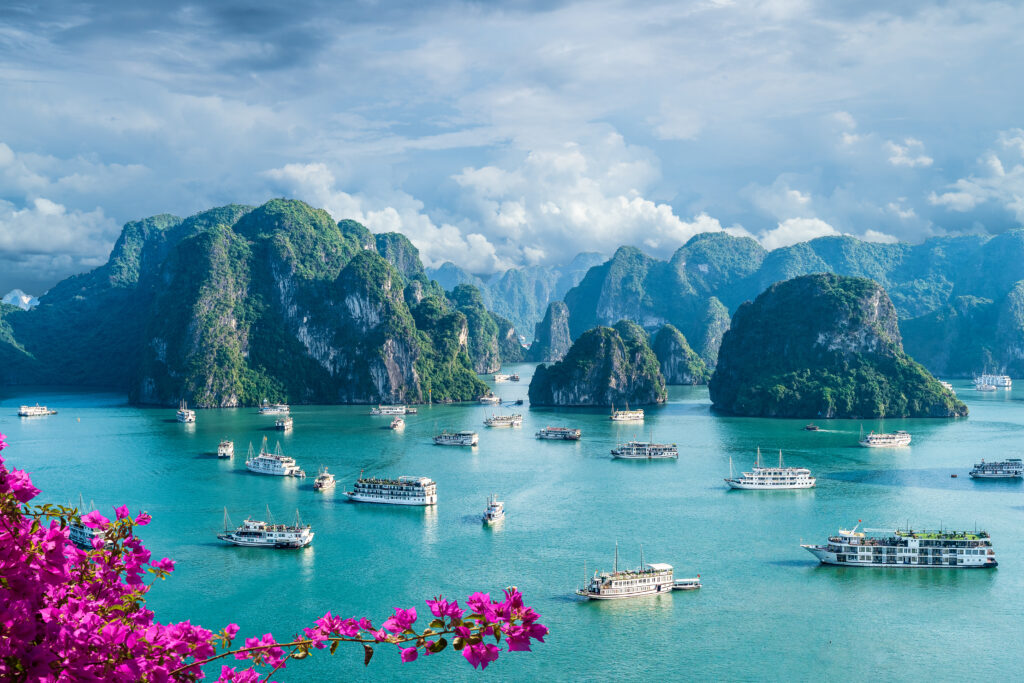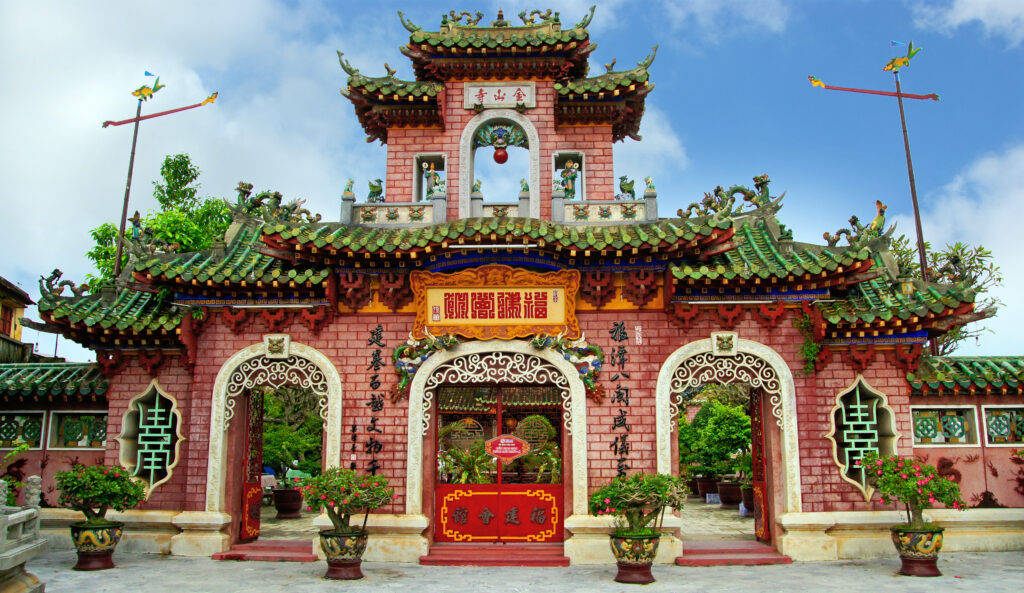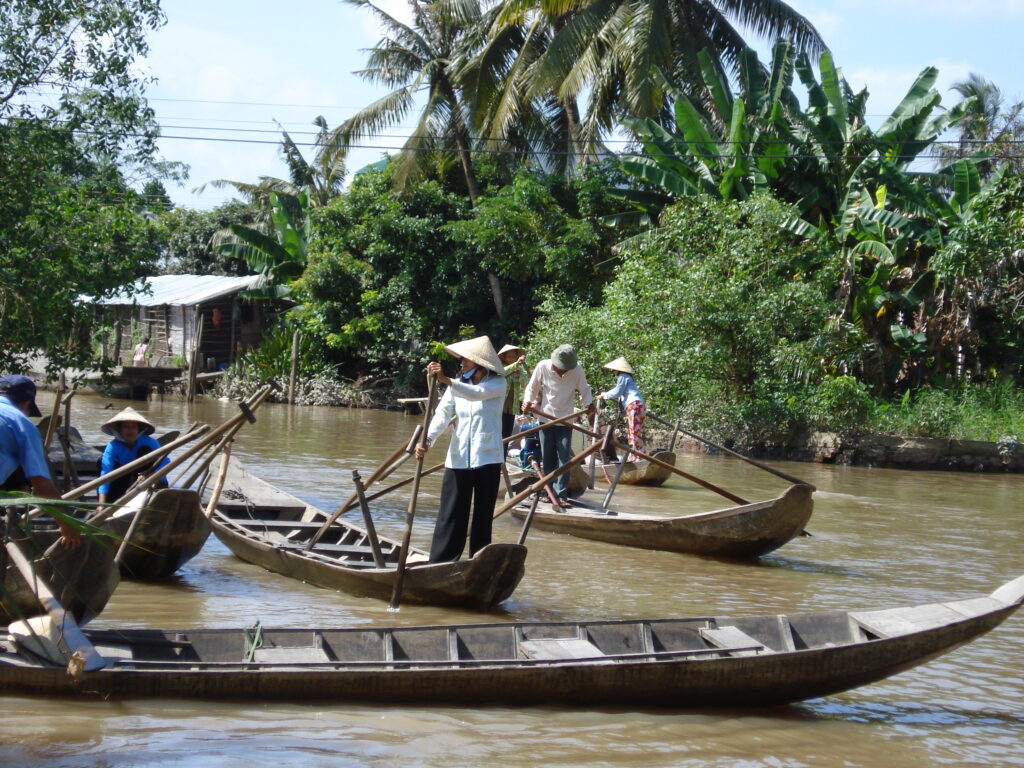
This 2-week Vietnam itinerary will allow you to see the country's most beautiful sites. We've designed it to mix culture-rich cities with more natural, relaxing landscapes. It's fast-paced to give you a good overview of the country, but not at breakneck speed, so you'll have time to appreciate every moment. You'll land at Hanoi airport and depart from Ho Chi Minh City airport, both with good connections to Europe. By choosing two different airports, you'll be able to follow a more extensive circuit of this long country.
Petit Futé tip: Take advantage of a discount by booking your travel insurancehere, and leave with peace of mind!
Days 1 and 2: Hanoi

To start your 2-week itinerary in Vietnam, you'll land at Hanoi airport, in the north of the country. It's well connected, with direct flights from Paris and Frankfurt, and even more options if you opt for a stopover flight. The airport is located some 30 km from downtownHanoi, to which it is linked by shuttle buses and cabs. It's well equipped, with currency exchange services, phone booths and car rental agencies. Then set off to explore Hanoi, staying for two nights.
Book a cheap guided tour : we recommend that you book this guided tour of Hanoi that will take you to all the must-see places in Hanoi for... 1.95 per person!
The article to read to organize your stay: What to do and see in Hanoi? The 17 must-sees
See Ho Chi Minh's mausoleum
Ho Chi Minh's mausoleum is one of Hanoi's most visited sites, not only because it provides an insight into the country's history, but also because of its architectural interest. It houses the body of Ho Chi Minh, the first president of the Democratic Republic of Vietnam and considered the father of the fatherland. The mausoleum was built on the very spot where he proclaimed Vietnam's independence in 1945.
Admire the One Pillar Pagoda
The One Pillar Pagoda, or Môt Côt Pagoda, was built in the 11th century on the orders of Emperor Lý Thái Tông. Legend has it that the emperor, wishing for an heir, dreamt of a goddess in a lotus who promised him one. Shortly afterwards, he finally had a son, and had the pagoda built on a pillar in the middle of a lotus pond. Visit it to admire its beauty and to better understand the place of spirituality in Vietnam.
Photograph the Temple of Literature
The Temple of Literature was built at the same time as the previous temple, but was much better preserved. It is dedicated to the cult of Confucius. The temple also served as a university, where the elite were taught Confucian philosophy. Go there to better understand the country's history, spirituality and Chinese influence, and to admire this unique architecture.
Lose yourself in the old quarter
The streets of Hanoi's Old Quarter are the perfect place to get up close and personal with the local culture during your 2-week Vietnam itinerary. Each alleyway is dedicated to a type oflocal craft : silk, metals, paper... While the district has modernized somewhat, it remains the best place to experience Vietnamese tradition. You'll also find colorful fruit and vegetable stalls, excellent typical restaurants and boutiques. You'll be able to buy tailor-made clothes, traditional sweets and other souvenirs.
Must-read: for even more travel inspiration, check out our selection of the best vegetarian destinations.
Attend a water puppet show
Hanoi is famous for an amazing tradition: puppet shows on water. This tradition is thought to have originated a thousand years ago, when the rice paddies of northern Vietnam were periodically submerged under water and the locals wished to be entertained. Today, these shows no longer take place in the rice fields, but rather in traditional theaters equipped with ponds. The show is accompanied by musical instruments and singers. The Thang Long Water Puppet Theater is Hanoi's best-known venue for this kind of show during your two-week itinerary in Vietnam.
To book : take advantage of our partner's rates by booking your tickets for the water puppet showright here.
Days 3 and 4: Ninh Binh

On this third day of your 2-week Vietnam itinerary, leave Hanoi in the morning and head for Ninh Binh. The train is by far the easiest way to get to Ninh Binh, with a journey time of just 2 hours. It's best to book your ticket in advance, either online or directly at the station on arrival in Hanoi. Then stay two nights in Ninh Binh, the land side of Halong Bay, which you'll then discover by sea.
The most popular option: we recommend booking this excursion from Hanoi to Ninh Binh, Trang An, Bai Dinh and Mua Cave. You'll visit the temples of Bai Dinh, take a scenic boat ride through Trang An and admire the views from the Mua caves.
If you prefer, we also recommend this day trip to Tam Coc, Hoa Lu and the Mua caves from Ninh Binh. You'll visit three caves, enjoy a Vietnamese lunch and visit traditional villages by bicycle.
Explore Tam Coc or Trang An
Tam Coc is located on landlocked Halong Bay, a natural area of caves and a river. Explore this unspoilt environment by boat, skirting rice fields overlooked by mountains and exploring rocky cavities. The guides leading the tourists on the boats usually try to offer to buy their handicrafts as well. Or opt for a visit to Trang An, a similar natural site where water and caves mingle. Both Tam Coc and Trang An are Unesco World Heritage sites.
Visit the Bai Dinh pagoda
The Bai Dinh pagoda is one of the largest religious complexes in Southeast Asia. The Buddhist temples, old and new, stretch over 700 hectares. In all, the site is home to 500 Buddha sculptures. Between the traditional buildings, nature reclaims its rights, forming an exceptional landscape that deserves to be included in your 2-week Vietnam itinerary.
Hike to Hang Mua
Hang Mua is an enchanting rocky peak topped by a pagoda, close to Tam Coc. Climbing to the top is difficult, as there are many steps to climb, but the view over the fields pierced by mountains is well worth the effort.
Related article: for a magical trip, take a look at our article on discovering secret Vietnam.
Days 5 and 6: Halong Bay cruise

On the fifth day of your 2-week Vietnam itinerary, we leave Ninh Binh for a cruise on Halong Bay. Most cruises depart from Halong, the town from which the bay takes its name. These trips generally last 24 hours, starting at midday and finishing at the same time the following day. You'll sleep one night on board, and the next day board an overnight train or flight to your next destination, Hué.
Related article: to organize your autumn vacation, check out our selection of the best destinations in November.
Embark on a cruise on Halong Bay
A cruise on Halong Bay is one of the most exotic and extraordinary experiences you can have on your 2-week Vietnam itinerary. You'll board a junk, a traditional Vietnamese sailing vessel, and sail between the various islets that make up this sublime landscape. The sunset will undoubtedly be one of the most beautiful of your life. Depending on your preferences, you can also opt for a cruise lasting just a few hours, or two days or more. We recommend that you spend at least one night on board to really get away from it all. One or more traditional meals will be served on board, usually including seafood.
To book: The most popular option for visiting Halong Bay is certainly the Halong Bay Day Cruise , which you can book book here. You'll explore Sung Sot Cave, Titop Island, kayak Luon Cave and swim in the blue waters of Titop's crescent-shaped beach.
Days 7 and 8: Hué

You leave Halong Bay on the sixth day, as the cruise lasts only one night. The journey to Hué is then a major one, and you have two main options. First, you can return to Hanoi and fly to Hué. Flights are very frequent, inexpensive and take around 1 hr 15 min. Another option, which takes longer but is also cheaper and allows you to enjoy the scenery, is to take the train. The journey takes around 14 hours, but there is a direct night train that allows you to enjoy the journey from the comfort of a couchette. You'll then arrive in Hué, the former imperial capital of Vietnam. Stay for two nights.
To book : take advantage of your stay to book this guided walking tour of Hue's imperial citadel and Forbidden City. Discover Hue's history and royal Vietnamese culture.
Visit the Imperial Citadel
The Imperial Citadel is Hue's most emblematic monument. It houses the ancient imperial city, surrounded by a moat and thick fortifications. The imperial city houses the imperial yellow city and the forbidden purple city, once reserved for the emperor. You can visit the site on your own, but it's best to be accompanied by a guide to understand all the secrets of this fascinating site.
Enjoy a boat trip on the Perfume River
The Perfume River is the name of the river that flows through Hué before emptying into the South China Sea. There are several explanations for the river's name: it is said to derive from the scent of incense placed on the river during ancient ceremonies, or from the flowers of the trees on its banks. Whatever the case, the river offers breathtaking scenery, best admired on a fast cruise. From the boat, you can also admire the rich historical heritage of the city of Hué along its banks, including the imperial tombs. There are various offers of varying lengths, sometimes including services such as tea tastings. We recommend you book this one, a half-day guided boat trip on the Perfume River.
The article to read: make the most of your trip by consulting our article on the advantages of using a French-speaking travel agency in Vietnam.
Good to know: if you'd like to opt for a personalized travel itinerary in Vietnam, we recommend that you request a free quote right here. A tailor-made, responsible trip, direct with the best local agencies, awaits you!
Days 9 and 10: Hoi An

Hoi An lies 120 km south of Hué. The route between the two is particularly beautiful, passing through the Col des Nuages, a panoramic mountain road. The easiest way to get there is by bus, which takes around 3.5 hours and is quite affordable. You can also rent a car or hire a private driver to make stops along the road, which offers plenty to see. Once in Hoi An, stay for two nights before resuming your 2-week Vietnam itinerary.
Remember to book your guided walking tour right here of Hoi An one of Vietnam's most renowned ancient cities, with a rich history dating back to the 16th century.
Explore Hoi An Old Town
Hoi An's Old Town is one of Vietnam's most beautiful, so much so that it has been designated a UNESCO World Heritage Site. It's probably one of the most beautiful places to visit in Vietnam. Stroll through the narrow streets by day or by night, when they are lit up with lanterns.
Cycle through the rice paddies
All around Hoi An lie beautiful natural landscapes that should be included in your 2-week Vietnam itinerary. If you leave the city by bike, you'll soon find yourself pedaling through rice paddies. With the sea not far away, you can even reach some beautiful beaches.
Ride away to the My Son sanctuary
The My Son sanctuary is located an hour from downtown Hoi An, and is well worth the short journey. This complex of centuries-old Cham temples (found in Cambodia and Vietnam) is a UNESCO World Heritage site. This archaeological site reveals all its secrets on a self-guided tour or with a guide, to better understand its history.
Days 11 to 13: Hô Chi Minh-Ville

Hoi An and Hô Chi Minh-Ville are 900 km apart by road. There are direct flights almost every day from Da Nang airport, which are fairly short (1 hr. 20 min.) and inexpensive. There is also a train from Da Nang, even cheaper, but 19 hours long. Then stay in Ho Chi Minh City for two nights.
We recommend this great day trip from Ho Chi Minh to discover the Cu Chi tunnels and the Mekong Delta. A great cultural immersion with visits to small traditional villages.
Stroll through Ho Chi Minh City
Vietnam's largest city is full of treasures, including a rich French colonial heritage that can be admired in hotels and theaters. Rich in influences, the city also boasts an interesting Chinatown. For a taste of the local cuisine, don't miss the Ben Thanh market. Built by the French in 1912, it remains the city's largest covered market.
Visit the War Remnants Museum
Ho Chi Minh City's War Remnants Museum is perhaps the city's most interesting museum. It deals with both the Indochina War (1946 - 1954) and the Vietnam War (1955 - 1975). Numerous photographs plunge visitors into the country's battered history. The museum, a veritable memorial site, is housed in the former premises of the American news agency.
Must-read article: check out our other Vietnam tours, to help you plan your trip.
Take a trip to the Mekong Delta
From Hô Chi Minh-City, an excursion to the Mekong delta is an activity that will mark your 2-week itinerary in Vietnam, as well as allowing you to practice sustainable tourism. You'll be able to visit floating markets such as Cai Be.
Day 14: Return from Hô Chi Minh City
For your return journey, you'll take off from Hô Chi Minh-Ville airport. There are direct flights to Paris, Frankfurt and Munich.
Are you tempted? Take a look at our airfares and book now !


